#Kirk the Storyteller
Explore tagged Tumblr posts
Text

@clyde49 Kirk the Storyteller article from 1987
4 notes
·
View notes
Text


Jim Henson Presents #3 by Kyla Vanderklugt, Seanan McGuire, VV Glass, Shobo Coker, Countandra, Aabria Iyengar and Jared Cullum. Cover by Miguel Mercado. Variant cover by Derek Kirk Kim. Out in March.
"Writer Seanan McGuirre and artist Countandra continue the story of the Heretic, SkekGra. Meanwhile, Shobo and V.V. Glass bring us a Yoruba storyteller tale about Ijapa the Tortoise. Discover a rare moment of introspection from Jareth the Goblin King written and illustrated by Kyla Vanderklugt. Finally, delight in the tale of a baking + architecture contest amongst the Doozers written by Aabria Iyengar and illustrated by Jared Cullum."
#jim henson presents#jim henson#the dark crystal#the storyteller#labyrinth#fraggle rock#farscape#boom studios#archaia#kyla vanderklugt#shobo coker#vv glass#seanan mcguire#countandra#aabria iyengar#jared cullum#miguel mercado#derek kirk kim#variant cover#comics
29 notes
·
View notes
Text
you know it’ll be a good star trek episode when it starts with the Evil Bad music
#tos episodes that started in the middle of a crisis were so fun really#it was really evident to me of the slight shift in storytelling they were going through#it became less formulaic that way#star trek#star trek the original series#star trek tos#spock#james t kirk#tos
67 notes
·
View notes
Text
I think storytelling is important because it is the origin of hope. All these characters we love - flawed and anxious and broken - have shit explode in their face and just keep going.
Star Trek has a myriad of themes but its main message is, still, hope. Kirk doesn't believe in no-win scenarios. Spock spends his entire life fighting an identity battle and ends up being an advocate for reunification. Picard gets consumed by the Borg and still goes on to order his fucking Earl Grey.
Star Wars has it, too. Obi-Wan loses everything: his family, his padawan, his place in the world. So he builds himself a new purpose in watching over Luke. Hell, even Anakin is motivating as a villain who could have chosen to give up but somehow didn't.
I think this is why these stories resonate with so many people. We are subtly reminded of the possibility to reinvent ourselves. Even if the odds state plainly that the Dominion War would be lost, even if the forces at play are bigger than us. We tell each other stories and we believe.
#storytelling#inspirational#philosophy#reflection#star trek#kirk#spock#jean luc picard#star wars prequels#obi wan kenobi#anakin skywalker
15 notes
·
View notes
Text
You're doing yourself a disservice by not reading Heaven Help the One Who Leaves!
#A Film by Kirk is a tremendous storyteller#Jess will break your heart#You'll fall in love with everyone all over again#gilmore girls#literati#fanfic#fanfic rec#Fanfiction
5 notes
·
View notes
Text
https://youtu.be/L45NWKEjYy8
youtube
Absolutely amazing 🤩
#william shatner#captain kirk#star trek#actor#tv#movies#scifi#Roddenberry archive#talks#science fiction#60s#nostalgic#virtual#starship#enterprise#space#storytelling#original#Youtube
13 notes
·
View notes
Text
i promise i will at some point stop putting shatner on your dash but it will be probably a matter of weeks. sorry
#p#combination of episodic storytelling making follow up difficult + generally reserved character AND 60 years of reinterpretation#has him (kirk not shatner) stuck firmly in my head. will stop when i feel like ive puzzled him out probably
1 note
·
View note
Text
Sexism in TOS: Worst Offender, or Progressive in Retrospect in Comparison?
I see a lot of folks claim that TOS was the most sexist of the Star Trek shows by a landslide -- and while I agree that it definitely suffered from the sexism of the times, I also have other perspectives to share to give some food for thought.
I am of course not insinuating that TOS isn't sexist -- it is, but I have to ask folks to consider the breadth and depth of Berman's sexism in his run and ask yourself: Was Gene Roddenberry genuinely more sexist in his storytelling and delivery than Rick Berman?
I'm not telling you to feel one way or the other, but all I ask is that you hear me out and consider some perspectives and make your own balanced assessments. Nobody is obligated to share my opinion, but it means a lot just to have folks hear it and see their thoughts on the subject. So here is what I was originally responding to:
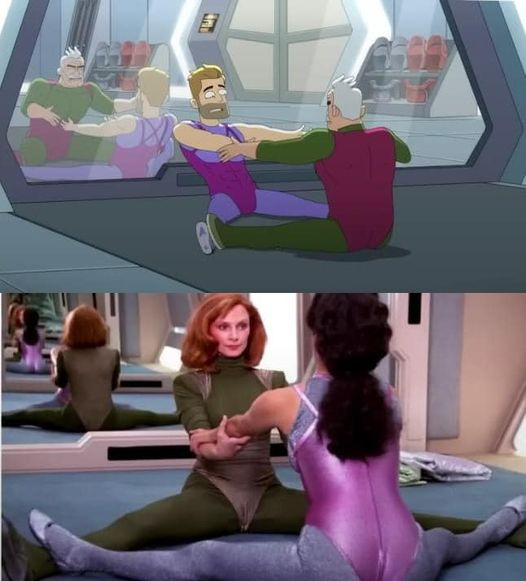
Someone's response to this photo:
"Devil's advocate. This was a part of the popular form of cardio during the production time of TNG. Yes, it was heavily sexualised by men, but so is literally every other way women work out. Men have been caught taking pictures of women while trying to do dead lifts, running on tracks and working on sled machines. They post them online to share too. The fact is, there is no way a woman can be shown working out without it going there. And yeah,t hat includes the combat forms of workout they do in Star Trek. Just look at how Dax dresses when she spars with Worf. Yes, they're dating, but still, same goes when 7 does and any other female.
Aerobics routines like this were made dirty and cringy. This was what women wore then by and large. This is how the workout was done. We make it cringy."
My response to them:
"I respect your take, but I disagree on a few fronts.
The miniskirt was chosen by the TOS female cast, not the male cast, specifically requested by Grace LW and affirmed by Nichelle and Majel who would go on to vehemently defend the miniskirt over the years as comfortable and embraced by them.
Grace said it was comfortable and seen as a symbol of female sexual empowerment during the 60s and thought it would be a progressive garment (and turns out that it was, as it was later adapted and worn by male crew as a skant on TNG) -- FYI those were designed by a gay man and Gene approved them.
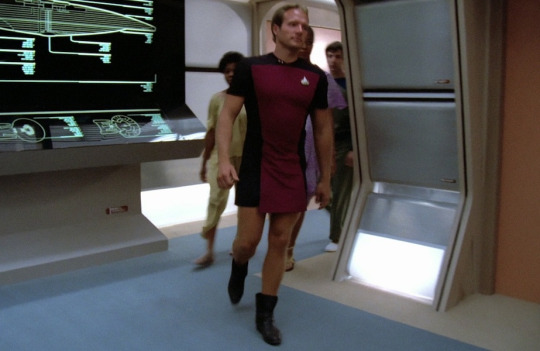
This was also supposed to be Spock's TMP outfit:
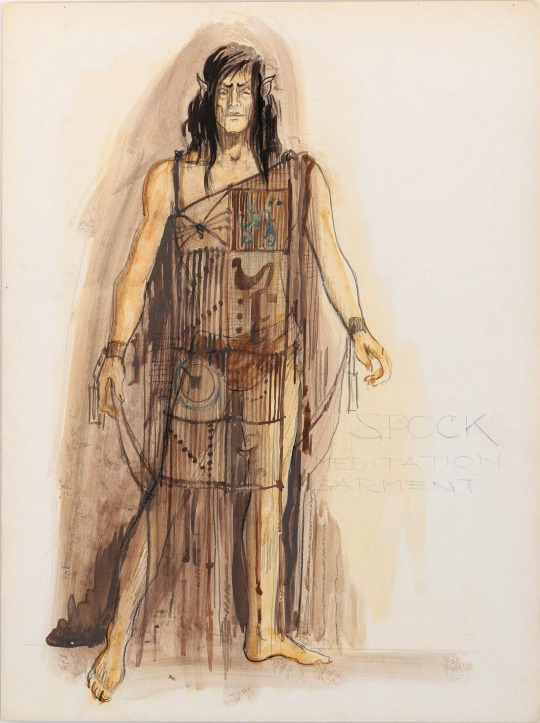
Literally lingerie.
We saw both Uhura (who saves Kirk in from Marlena Mirror Mirror) and Yeoman Landon (the first to initiate combat with a classic Kirk-esque kick to help the Captain being attacked in The Apple) carry out their combat training in their Starfleet uniforms without ever being made to change into any ridiculous workout gear.
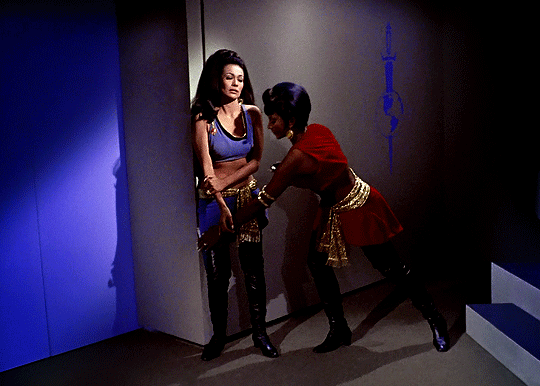

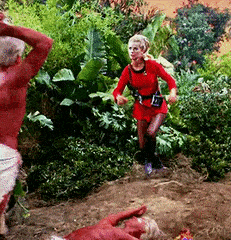
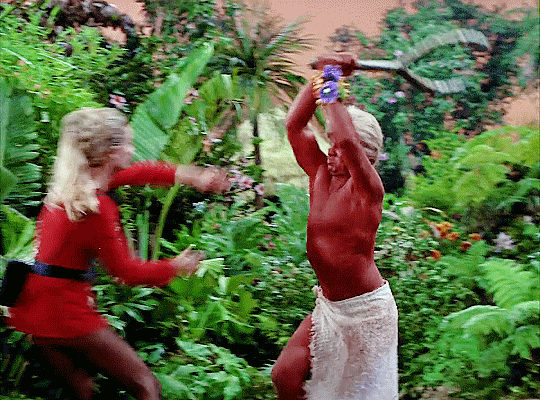
In fact, I'd argue Jim Kirk was sexualized even more than the ladies of the week on the show and I saw his naked body more than anyone else's on a fairly regular basis. He wore red yoga tights while topless in Charlie X while the women wore full length gymnastic suits that covered their entire body. If anything, it went out of its way to avoid sexualizing women practicing fitness in those scenes and instead focused on Kirk.
Gene confessed that he asked to have Shatner filmed in suggestive/provocative ways to "give something to the ladies", so he -- as he said -- liked to "film him walking away" or have him conveniently busting out of his shirts in just about every episode as it were, because Shatner apparently had great assets. LOL
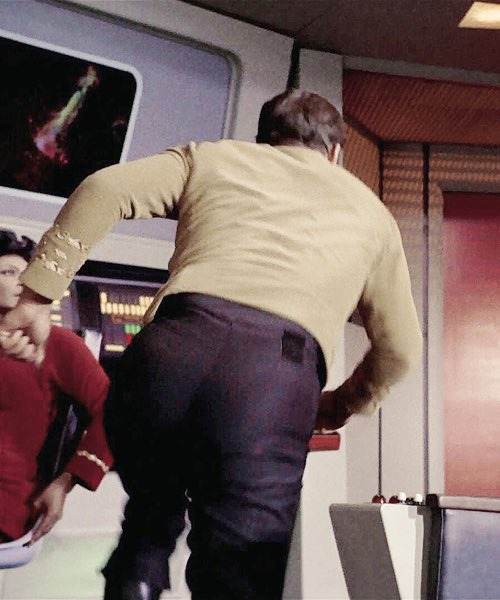
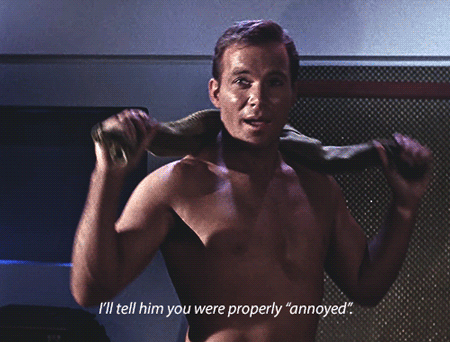
Gene made an effort to at least sexualize both if he was going to sexualize one, and he carried that attitude forward in wanting the m/m and f/f scenes in the background on Risa for TNG. He also insisted that the men and women wear skimpy outfits on THAT TNG planet. You know the one. LOL I mean the dudes even had on less than the women:
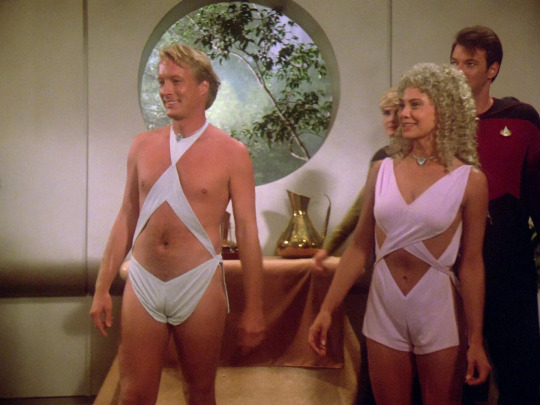
Gene also gave permission to K/S shippers to have their conventions back in the 70s when he was asked for permission. Gene and Nimoy felt with all the skimpy outfits they had the ladies wear, why not let the ladies and gay men have their fun, too? It's how we ended up with moments like this:
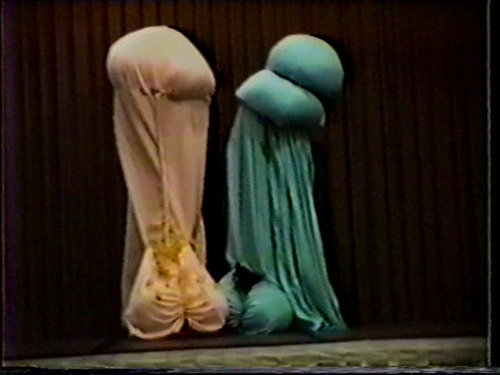
Yes, those are two people dressed up as Kirk and Spock's penises doing interpretive dance. Gene didn't give two damns. LOL
In my eyes, that was a very progressive take on Gene's part for the 60s. It was actually PARAMOUNT STUDIOS who had the big problem with K/S stories and vehemently tried to shut them down. Gene literally hired slash authors on his payroll and even had several slash stories/writers published in his official Star Trek books (The New Voyages & The New Voyages II).
I feel I saw Uhura and women in TOS engaged in more physical combat/altercations defending themselves that Troi or Bev were shown holding their own.
In fact, Kirk used to get furious when someone would "dress up" his female crew members without their consent (Trelane episode, Shore Leave episode) because like his male crew members, he wanted them to be treated professionally and to also have his male crew act professionally.


Berman brought some of his own personal biases into Star Trek that in some ways regressed it. While TOS had blatant sexism and was called on it time and again, that show was made in the 60s -- a solid 21 years before TNG. We as a modern audience understood why some of it was cringe/sexist due to the time period -- look at any other media coming out in the 60s and Star Trek was miles ahead of what other shows were doing.
Compare that to Berman who was churning sexist stuff out when women like Starbuck and Scully were simultaneously on screen on other programs airing, and we had already had Sigourney Weaver and other strong women in Holywood playing respectful roles.
In my eyes, there was no need of the sexism seen in TNG but especially VOY and ENT. There was no excuse for it when other shows were writing women far better and a number of those weren't even set in the future like Trek was, making it age even faster due to having those dated perspectives frequently highlighted.
In the Center Seat documentary as well as "The Fifty Year Mission" book you will find cast members, writers and other studio alumni who attest to this. Some discussions from "The Fifty Year Mission":
"First, Berman was supposed to have been a real sleaze ball . . . According to Terry Farrel, he would go on constantly about how her breasts weren't big enough, how she should do something about it, and how his secretary was a good example to follow as she had huge breasts. She even had to have fittings to get larger bras, and that was all done at his behest.
Later Berman and Braga developed a name for Jeri Ryan's character prior Seven of Nine. They originally called the character "perineum" which if you look it up it is the area between the anus and the scrotum. Later they floated the name "6 of 9". I mean, what does it tell you about where these two were coming from in the development of this character if they had names like that put forward in all seriousness for her?"
Gene Roddenberry also had some of his own more progressive ideas for TNG cut or watered down by Berman. Roddenberry agreed TNG should have homosexual relationships and representation at a con in the 80s and insisted on it in a meeting with his writers -- something Berman later would not honor. Gene wanted the AIDS episode, showing m/m and f/f in the Riza scenes -- these were some of Roddenberry's requests to include in TNG that Berman later stonewalled.
Berman's era was sadly dated by his own misogynist bias, IMO, to the point that it can somewhat hurt the shows he worked on through his cringe egoism and blatant disrespect toward his female cast.
There is a reason why Gene could keep female actresses working with him and Berman had a revolving door of women that he couldn't seem to keep working for him -- he was abhorrent to women, on and off set. Gene wasn't perfect at all, he had a lot of issues himself -- but Berman was a whole other level. Just look at what he did to poor Jolene Blalock, Marina Sirtis and his toxic commenting on her body weight which exacerbated her struggles with eating disorders, or how he treated and talked to Terry Farrell.
Anyway, just some food for thought. I'm not saying anyone is wrong regarding a take like that, but there are a variety of ways to look at this. Gene Roddenberry isn't a saint by any means, but it definitely bothers me how folks will tote the Berman era as if it were the lesser of two evils or the more progressive depiction of women when I felt there were far more concerning portrayals of women in his era with far less justification.
(P.S: I don't event want to go near the sheer amount of "creepy old dude/villain preys on innocent/naïve/scared young woman or little girl" stories there were in Berman's era, either. But that's a whole other can of worms I can write about in a part 2.)
#star trek#star trek tos#star trek tng#star trek voy#star trek ent#star trek ds9 was the one show that went above and beyond#1shirt2shirtredshirtdeadshirt#oc#octrekmeta#octrek#gene roddenberry#rick berman#brannon braga#kirk#spock#uhura#rand#nichelle nichols#majel barrett#grace lee whitney#tos#tng#voy#ent#marina sirtis#jolene blalock#terry farrell
4K notes
·
View notes
Text
Why Does Unification (Short Film) Hit Us So Hard?
The emotional impact of Unification (the short film) stems not only from the reunion of Kirk and Spock but also from the real-world circumstances surrounding these characters and the actors who brought them to life. Here's why I think it hits so deeply:
1. The Reality of Time
Leonard Nimoy is gone, and William Shatner is in his 90s. This reality hangs over the reunion like a shadow, making it impossible to separate the story on screen from the lives of the actors (Nimoy and Shatner were estranged at the time of Nimoy's death). For fans who have grown up with Kirk and Spock, this reunion feels like one of the last moments to celebrate their shared legacy, a reminder that even legends aren’t immune to the passage of time.
2. K/S: A Bond That Transcends
The love and friendship between Kirk and Spock has always been the emotional core of Star Trek. Their reunion after 100? years is more than a plot point—it’s a metaphor for the enduring connection between two people who defined an era of storytelling. Seeing them together again feels like the universe itself is giving us one final gift.
3. A Farewell to TOS
For many, this feels like the end of The Original Series. With Nimoy gone and Shatner's advanced age, Unification represents closure for a chapter of Star Trek that shaped generations of fans. This moment isn’t just about the characters reuniting—it’s about fans saying goodbye to a piece of their own history.
4. A Reflection on Mortality
Watching this reunion is an emotional reminder of our own lives. The passage of time, the inevitability of loss, and the joy of reconnecting with those we’ve loved are universal experiences. The film invites us to reflect not just on Kirk and Spock’s journey but on our own relationships and what it means to hold onto those bonds, even as time changes everything.
5. The Legacy of Kirk and Spock
Kirk and Spock aren’t just characters—they’re symbols of everything Star Trek represents: adventure, loyalty, and the power of love and friendship. Their reunion after so many years is a reminder of the ideals they stood for and how those ideals have shaped not just the franchise, but the lives of countless fans.
Why Is Unification So Emotional?
It’s because this moment encapsulates both a fictional and real-world goodbye. This reunion feel like one last chance to honor the characters and the actors who portrayed them. It’s the end of an era, a farewell to a story and a friendship that has inspired millions.
For fans, Unification isn’t just a reunion—it’s a final bow. It’s emotional because it reminds us that even the brightest stars eventually fade, but the light they leave behind will always guide us.
What do you think?
82 notes
·
View notes
Text



Plain Jane and the Mermaid by Vera Brosgol. First Second, 2024. 9781250314864. 364pp. Includes an author's note, sketches, beat boards, and two wonderful pages on the coloring process at the end. (The book was colored by the mighty Alex Longstreth.)
Jane's parents have just died, and her awful male cousin is set to inherit everything. He also intends to kick Jane out of her home. She has nowhere to go, but if she gets married, she'll receive a sizeable dowry.
Jane secretly loves Peter. He works with his father, a fisherman who enjoys his son's manner as little as Jane's parents liked how she looked. Jane works up her courage, though, and proposes to Peter. He's more than a little rude about it, and then he's kidnapped by a mermaid. With a little magical help from a woman in town, Jane sets off after him.
What follows is an adventure involving selkies, a mighty water demon, undead sailors, and the quest for eternal youth. Throughout, Jane is brave and kindhearted and the kind of person I wish I had more of a chance to root for. This may be my favorite of Brosgol's books, which is saying something considering how much my daughter and I love Anya's Ghost; her art and storytelling get better with every book.
Worth noting: This graphic novel uses spot gloss perfectly on the cover. Hats off to Kirk Benshoff, the cover designer.
38 notes
·
View notes
Text
I do love this phenomenon.
But I admit: I also love when they break it.
This is true of almost every well-done story: When heroes behave selfishly, villains act for the greater good, etc., those are the story’s best moments. Establish a pattern in plot, characterization, lore, etc. and then the times that go against that grain are often the most interesting.
This is the why so many captains break the Prime Directive it’s become a joke, and for Spock the Vulcan—a race known for its decision to rely on logic and not be outwardly emotive—so many of his most interesting storylines are about how and when and why he feels.
In the same way, I love it when the heroes choose “selfish” reasons for doing stuff.
When Pike and Spock (and Ortegas, M’Benga, La’an and Sam) crossed the Gorn demarcation against Adm. April’s orders: Mostly to look for Marie & Christine.
When M’Benga spent a season keeping his daughter in the pattern buffer.
When Spock and Uhura and the crew stole the Enterprise because La’an personally sent out a distress call.
When Christine spent an entire episode trying to change Spock back into a hybrid mainly because she loved both his halves.
When La’an told Jim about time travel so she wouldn’t have emotional vulnerability forced out of her in song form.
When Pike spent months lying to Starfleet for Una.
When the crew admitted Marie back onto the Enterprise—even after Hemmer, and even after La’an’s trauma with the Gorn.
When Uhura wanted to leave the doors open to save Hemmer, knowing full well he was Gorn-infected with no way to be saved.
When Spock almost went to war with the Klingons because that extra second might save Christine’s life.
And on and on.
Not because it’s ooc for Starfleet. But because those are the moments that tell you most about character.
Star Trek is so funny. All of starfleet is so aggressively Neutral Good. Every time they're up against something they Always do the noble thing. Every one of these motherfuckers is so ready to jump on the grenade. It's so cute I love them
#writer thoughts#star trek snw#star trek strange new worlds#star trek: strange new worlds#star trek: snw#Star Trek#star fleet#christopher pike#captain pike#spock snw#snw spock#christine chapel#nurse chapel#marie batel#captain batel#joseph m’benga#la’an noonien singh#nyota uhura#snw uhura#star trek spoilers#snw spoilers#spapel#erica ortegas#sam kirk#james t kirk#admiral april#storytelling
11K notes
·
View notes
Text
Have you played Star Trek Adventures: Captain's Log Solo Roleplaying Game ?
By Michael Dismuke, Jim Johnson, John Kennedy, Thomas Marrone, Aaron M. Pollyea, and Al Spader

BOLDLY GO WHERE NO ONE HAS GONE BEFORE
“THERE’S NO SUCH THING AS THE UNKNOWN; ONLY THINGS TEMPORARILY HIDDEN, TEMPORARILY NOT UNDERSTOOD.” -CAPTAIN JAMES T. KIRK
The Captain’s Log Solo Roleplaying Game is a 326-page, full-color standalone digest-sized rulebook that provides a complete, streamlined version of the award-winning 2d20 System used for the Star Trek Adventures roleplaying game, which you can use to create your own Star Trek stories with a dynamic character formed from your own imagination.
Whether you are venturing into the cosmos alone, conducting Galaxy-spanning missions cooperatively with friends, or exploring the unknown with a gamemaster facilitating your adventures, use the guidance and random tables contained in Captain’s Log to generate countless hours of memorable adventures in the Star Trek universe.
Create an original character and then use the tools in this book, combined with your fertile imagination, to fashion your own fascinating Star Trek-style stories. Play in any era of Star Trek - from the 21st century to the 32nd century and everything in between. Explore strange new worlds, new civilizations, and all the wonders of the universe!
What will you discover while exploring the final frontier?
The 326-page, full-color digest-sized hardcover Captain’s Log Solo Roleplaying Game features:A streamlined 2d20 ruleset that enables countless ways to play. Lifepaths and roles for any type of character, not just Starfleet captains. Story-driven solo gameplay that promotes drama in a safe space. A Star Trek primer including society, technology, and eras of play. Rules for creating or randomizing your own starship or starbase. Options to play the game solo, collaboratively with friends without a gamemaster, or collaboratively with a gamemaster Guidance on implementing the rules and telling your own stories. Over 100 random tables and storytelling matrixes usable in all kinds of games, including alien worlds and polities, allies and enemies, mission themes, maintenance downtime, and so much more! Available in four different covers inspired by your favorite Star Trek eras: the original series, The Next Generation, Deep Space Nine/Voyager, and Discovery. The interior content is the same for each version.
This book is a standalone product.
#ttrpg#tabletop rpg#poll#poll time#2020s#united kingdom#star trek#star trek adventures#star trek adventures captain's log solo roleplaying game
32 notes
·
View notes
Text
My K/S Novel Is Now Complete!
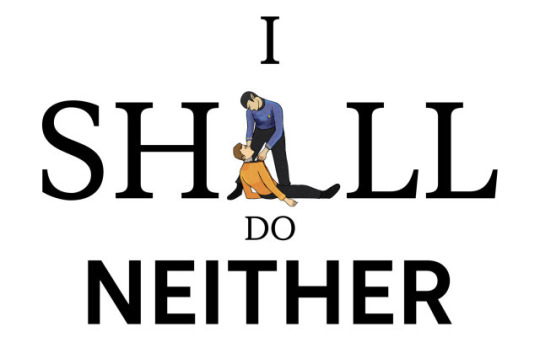
Some of you might remember me posting snippets of it week-to-week. I'm super excited to share that it's now fully complete, clocking in at 26 chapters (and a title page), spanning over almost 166,262 words. I worked incredibly hard on this and I'm so happy to have this work finished.
Here is the link to it, with more details under the cut.
I Shall Do Neither (166262 words) by onwhatcaptain Chapters: 27/27
Fandom: Star Trek: The Original Series, Star Trek Rating: Mature Warnings: Creator Chose Not To Use Archive Warnings Relationships: James T. Kirk/Spock, James T. Kirk & Leonard "Bones" McCoy & Spock Characters: James T. Kirk, Spock (Star Trek), Leonard "Bones" McCoy Additional Tags: Romance, Angst, Heavy Angst, Loss of Control, Psychological Trauma, Mutual Pining, Five Year Mission (Star Trek), Episode: s02e05 Amok Time, Post-Episode: s02e05 Amok Time, Pon Farr, Pon Farr Aftermath (Star Trek), Unresolved Sexual Tension, Friendship, Grief, Suicidal Thoughts, Suicide Attempt, Sexual Tension, Sexual Content, Unreliable Narrator, Vulcan Biology, Tarsus IV (Star Trek), Vulcan Mind Melds, Non-Linear Narrative, Storytelling Through Vignettes, Missing Scenes Between Episodes, Plot, Cover Art, Canon Divergence, Digital Art, Illustrations, In spite of the description Kirk features heavily in this novel Summary: In the wake of the kal-if-fee on Vulcan, Kirk is dead. When T’Pau tells Spock to live long and prosper, he knows he shall do neither. This is a story about men who love each other, and the lengths they will go to for one another. - Foolish, he thinks. I have been a fool.
How he had wanted so desperately to prove his Vulcan side. How all his life it had felt like a performance, and yet, to be finally subject to the most Vulcan thing of all destroyed him. The stripping of logic. All sense torn from him. His carefully constructed barriers had collapsed like a flimsy house of cards. To be granted his wish this way was a type of mockery. How he had wanted to be fully Vulcan. To prove that the blood which runs through his veins was not so human.
How wanting had been better than having.
71 notes
·
View notes
Text
It's really odd that I seem to find two different takes over how TOS Kirk was when young. In various novels from the 80s he portrayed at a goody two shoes who studies all the time and obeys every rule.
In 'modern' novels, even Shatner's own Star Trek Academy, Kirk is a too smart for his own good bad boy. (not quite AOS level but still)
The autobiography of James T Kirk does break that in that it's a more recent book and Kirk is obedient and smart.
I'm wondering if part of the reason is people think it's better storytelling or that it makes Kirk more interesting that way (maybe Kirk drift though I will argue a lot of how Kirk is known in pop culture didn't come out of a vacuum, feminist my ass). I personally do see TOS Kirk as a goody two shoes even if it is kind of boring.
And (oddly) I am enjoying Shatner novel (no, I know he didn't write it) but I feel it fits more as a AOS Kirk and Spock if Nero never happened. ( I mean they met as a strip club.)
#star trek#spock#jim kirk#star trek aos#star trek tos#james t kirk#aos kirk#Kirk drift#tos kirk#the autobiography of james t kirk
43 notes
·
View notes
Text

James with the Spooky puppet in a 1987 article.
The legendary Canadian children’s kids show host, James Kirkconnell

became involved with Space Ghost when he attempted to bring his brand of entertainment to Cartoon Network.

He would tell a classic fairy tale or folk story, and his illustrator would draw the key points. Although the execs didn’t think it worthy of it’s own time, Coast to Coast producers latched on to him, and the rest is history. However, he not only had been famous in Canada, but in the mid-50’s had even produced a version for public access TV in Philadelphia, PA. I found a bunch of the listings on Newspapers.com. Notice that in this version, he was accompanied by two puppet sidekicks, Nixie the Pixie, and Spooky the Spider

















Here is a photo of the Nixie Puppet

@deanky
@but-i-found-country-music
@vulgarjacket
@sutamatorega-crokertopoulos
@you-seem-frazzled
@ahyesmydocumentary
11 notes
·
View notes
Text
Star Trek Rewatch: Is there in Truth no Beauty?
TOS really likes setting up the conflict that women have to choose between accomplished careers and being able to have traditionally feminine things like romance, domesticity, etc. in a way that feels kind of dated. Especially when they link finding love, settling down, etc directly with being a woman itself. All that said, I do like how this episode handles it with Miranda.
And I think this is one possibility for what the episode's title is about. Miranda and Kollos are psychics and navigators, and this job represents performing a type of truth. But because Medusans are considered ugly and she'll be isolated from other humans, by choosing her job (truth) over humanity/femininity/domesticity (beauty) the question gets asked, is there in truth no beauty (as in by choosing truth is she rejecting or losing out on beauty/can beauty even exist in truth at all)? And the title is a question, and it's challenged throughout the episode. Miranda asks are Medusans too ugly to bear or are they actually too beautiful to bear? Kirk acknowledges being attracted to beauty and repulsed by ugliness is a prejudice.
There's also the roses, which represent beauty, but Miranda immediately pricks herself on a thorn when she's given one. Which calls into question if beauty should be uncritically considered the right choice. Is there not also the possibility of danger or being hurt with beauty?
Or the contrast between Kollos and Miranda and how Kollos is considered ugly, but what we see of their personality is compassionate and honourable. Or how Miranda is considered beautiful, but she has an ugly jealousy that lurks underneath that that likely would have gotten Spock killed if she hadn't confronted it. Which leads to the question, is beauty an illusion created through human perception and prejudice? Or the other possible interpretation of the episode title, is there in truth no beauty (as in does beauty even exist at all)?
And this is also Miranda's true internal conflict, it's not whether she wants to work with Kollos (i.e. choosing between work and finding love), we know she very firmly chooses Kollos. It's whether she's too human (too much beauty), to fully accept and embrace truth. And it's only when Kirk confronts her with this truth that she's able to accept it and work through it.
I also thought it was an interesting choice to make Miranda blind. There's a long history of associating blindness and truth--Justice with her blindfold, the ancient trope of blind seers, prophets, storytellers, etc. But I also really like the representation in general. Early Trek seemed to understand that a utopia isn't a world without disability, but where disability is accommodated as well as it possibly can be. Miranda's dress is an accommodation that works so well most of the characters didn't realise she was blind until it was pointed out to them.
Anyways, interesting episode. I really like this one.
23 notes
·
View notes